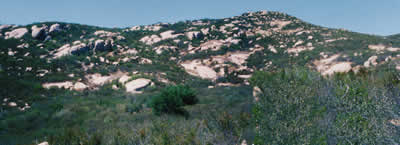Before the Planning Commission and in CEQA comments, EHL defended not only an iconic ranch near Julian but also 70,000 acres adjacent to the Cleveland National Forest.

The 1,500-acre, oak-studded Hoskings Ranch forms a scenic gateway to the town of Julian. A proposed subdivision would string residential ranchettes along the width of the property, break up intact wildlife habitat, and lead to the loss of the current cattle operation. In its comments on the Draft Environmental Impact Report, EHL noted the failure to consider an alternative that consolidated development in the least sensitive portion of the site and preserved agricultural uses.
With the expiration of mandatory restrictive zoning imposed by a 1993 ballot measure––the Forest Conservation Initiative (FCI)––some of the most remote and intact lands in San Diego could be developed. In its testimony before the Planning Commission, EHL noted a stark choice between such unwise development and maintaining the purposes of the General Plan to reduce fire hazard, reduce infrastructure and service costs, and protect wildlife habitat.
Early input by EHL and the Cleveland National Forest produced an environmentally superior alternative, which influenced the debate in a positive way. But powerful community groups and landowners sought conversion of habitat to estate lots. During public testimony before the County Planning Commission, a proposal to expand “village” boundaries in the town of Alpine was unmasked as a frenzy for growth outside of village boundaries, the result being more long distance commuters clogging the roads.
The Planning Commission, despite testimony from EHL, weakened a decent though still flawed staff recommendation for the FCI lands. In doing so, the Commission repeatedly ignored the sound planning criteria developed by staff in order to benefit selected landowners. When, as in one case, the basis for assigning density devolved to the number of children the owners happen to have, all consistency and fairness have been lost for those property owners assigned densities consistent with planning standards.
After final action by the Planning Commission, which includes a much needed second look at Alpine, this critical endeavor goes to the Board of Supervisors.


